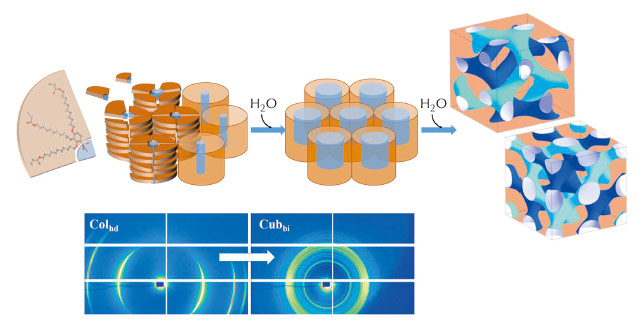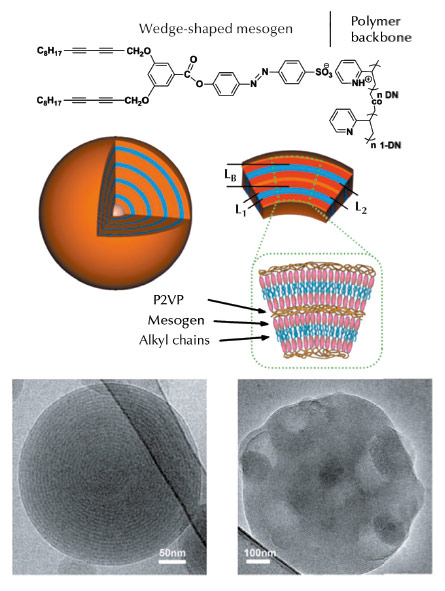- Home
- Users & Science
- Scientific Documentation
- ESRF Highlights
- ESRF Highlights 2013
- Soft condensed matter
- Nano-structured functional materials through self-assembly of wedge-shaped monomers
Nano-structured functional materials through self-assembly of wedge-shaped monomers
The self-assembly of biological molecules is the key for the generation of their well-defined functionality. In this process, water molecules play a significant role in defining the final structure and, consequently, the functionality. It is our ultimate goal to design functional materials with various morphologies that are typical of biological systems. For example, wedge-shaped amphiphilic sulfonate molecules can be viewed as analogue of proteins, which are able to form smectic (cf. β-sheet) or columnar (cf.α-helix) structures, depending on their molecular architecture [1-3]. In this work and previous [4,5], we explored the sequence of humidity-induced phase transitions in a novel wedge-shaped sulfonate molecule, sodium 2,3,4-tris (11’-acryloylundecyl-1’-oxy) benzene sulfonate (A-Na) (Figure 74), which serves as a model of a nano-channel-forming ion-selective membrane, using beamline BM26B.
 |
|
Fig. 74: Schematics of the self-assembly process of a wedge-shaped sulfonate forming supra-molecular columnar structures. The ionic nano-channels resulting from such a process swell upon water uptake (from left to right). At high relative humidity, the columnar structure transforms into bicontinuous gyroid and diamond phases. The corresponding X-ray patterns are given below. |
For the resulting supramolecular system containing ionic nano-channels, we demonstrate that a small amount of water can efficiently create highly conductive pathways for ions. Moreover, swelling of the initial hexagonal structure (Colhd) by water gives rise to a phase transition to bicontinuous phases (Cubbi), which is accompanied by formation of a percolating network of ion-conductive paths (Figure 74). The appearance of Cubbi phases on swelling further improves the conductivity, and can be of much interest for membrane technologies. Unlike columnar phases, the Cubbi phases would not require macroscopic channel alignment to maximise ion transport across the membrane due to their interwoven 3D channel networks. Our results provide a detailed view of the processes occurring in an ion-channel-forming system upon swelling. Importantly, it was shown that the supramolecular structures such as Colhd and Cubbi phases can be preserved upon polymerisation of their acrylic end-groups resulting in free-standing membranes with efficient ion-conduction. This work paves the way for the fabrication of mechanically stable nanoporous membranes with a tailored ion channel structure for applications in separation and catalysis.
Another application of molecular wedges could be in the design of functionalised micro-containers. Thus, we have shown that a liquid-crystalline complex of a polybase such as poly(2-vinylpyridine) (P2VP) and amphiphilic wedges bearing sulfonic acid groups at the tip (Figure 75a) forms onion-like multilamellar nano-sized vesicles in aqueous suspension. The structure of the complex in the vesicles is found to be similar to that in the bulk, where polymer backbones are sandwiched between the bilayers formed by the ligand molecules.
 |
|
Fig. 75: a) Chemical structure of the complexes of poly(2-vinylpyridine) and a wedge-shaped mesogen. b) Proposed molecular model of the onion-like vesicles. c) Cryo-TEM micrographs of the vesicles before (left) and after (right) UV irradiation. |
In contrast to conventional polymersomes, the polymer chains in this system are mainly parallel to the vesicle surface, contributing to their mechanical stability (Figure 75b). A large amount of remaining free binding sites (i.e. pyridine groups) makes it possible to incorporate functional molecules into the vesicles. Furthermore, a collapse of the vesicles can be induced by UV irradiation because of the trans–cis transition of the azo groups, which leads to isotropisation of the layered structure (Figure 75c). This feature can make this system promising for controlled delivery applications.
Principal publication and authors
J.J. Hernandez (a), M. Rosenthal (a,b), D.A. Ivanov (a,b), H. Zhang (c), L. Li (c), M. Möller (c) and X. Zhu (c), Adv. Mat. 25, 3543-3548 (2013).
(a) Institut de Sciences des Matériaux de Mulhouse (IS2M-CNRS) (France)
(b) Moscow State University Faculty of Fundamental Physical and Chemical Engineering GSP-1, Moscow (Russian Federation)
(c) Interactive Materials Research - DWI an der RWTH Aachen e.V. and Institute for Technical and Macromolecular Chemistry of RWTH Aachen University (Germany)
(d) Macromolecular Chemistry II, University of Bayreuth (Germany)
References
[1] U. Beginn, Prog. Polym. Sci., 28, 1049 (2003).
[2] G. Ungar, Y. Liu, X. Zeng, V. Percec and W-D. Cho, Science 299, 1208 (2003).
[3] V. Percec, A.E. Dulcey, V.S.K. Balagurusamy, Y. Miura, J. Smidrkal, M. Peterca, S. Nummelin, U. Edlund, S.D. Hudson, P.A. Heiney, H. Duan, S.N. Magonov and S.A. Vinlogradov, Nature 430, 764 (2004).
[4] M. Rosenthal, L. Li, J.J. Hernandez, X. Zhu, D.A. Ivanov and M. Möller, Chem. Eur. J. 19, 4300-4307 (2013).
[5] L. Li, M. Rosenthal, H. Zhang, J.J. Hernandez, M. Drechsler, K.H. Phan, S. Rütten, X. Zhu, D.A. Ivanov and M. Möller, Angew. Chem.: Int. Ed. 124, 11784 –11787 (2012).



